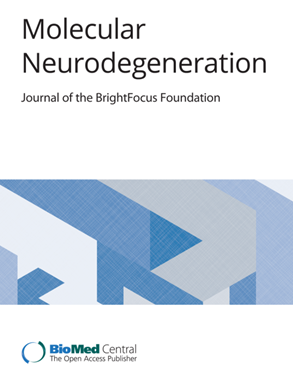Large-scale CSF proteome profiling identifies biomarkers for accurate diagnosis of frontotemporal dementia
IF 17.5
1区 医学
Q1 NEUROSCIENCES
引用次数: 0
Abstract
Diagnosis of Frontotemporal dementia (FTD) and its specific underlying neuropathologies (frontotemporal lobar degeneration; FTLD-Tau and FTLD-TDP) are challenging, and thus, fluid biomarkers are needed to improve diagnostic accuracy. We used proximity extension assays to analyze 665 proteins in cerebrospinal fluid (CSF) samples from a multicenter cohort, which included patients with FTD (n = 189), Alzheimer’s Disease dementia (AD; n = 232), and cognitively unimpaired individuals (n = 196). In a subset, FTLD neuropathology was determined based on phenotype or genotype (FTLD-Tau = 87 and FTLD-TDP = 67). Differences in protein expression profiles were analyzed using nested linear models. Penalized generalized linear modeling was used to identify classification protein panels, which were translated to custom multiplex assays and validated in two clinical cohorts (cohort 1: n = 161; cohort 2: n = 162), one autopsy-confirmed cohort (n = 100), and one genetic cohort (n = 55). Forty-three proteins were differentially regulated in FTD compared to controls and AD, reflecting axon development, regulation of synapse assembly, and cell-cell adhesion mediator activity pathways. Classification analysis identified a 14- and 13-CSF protein panel that discriminated FTD from controls (FTD diagnostic panel, AUC: 0.96) or AD (FTD differential diagnostic panel, AUC: 0.91). Custom multiplex panels confirmed the strong discriminative performancen between FTD and controls (AUCs > 0.96) and between FTD and AD (AUCs > 0.88) across three validation cohorts, including one with autopsy confirmation (AUCs > 0.90). Validation in genetic FTD (including C9orf72, GRN, and MAPT mutation carriers) revealed high accuracy of the FTD diagnostic panel in identifying both the presymptomatic (AUCs > 0.95) and symptomatic (AUC: 1) stages. Six proteins were differentially regulated between FTLD-TDP and FTLD-Tau. However, a reproducible classification model could not be generated (AUC: 0.80). Overall, this study introduces novel FTD-specific biomarker panels with potential use in diagnostic settings.大规模脑脊液蛋白质组分析鉴定准确诊断额颞叶痴呆的生物标志物
额颞叶痴呆(FTD)及其特定的潜在神经病变(额颞叶变性;FTLD-Tau和FTLD-TDP)的诊断具有挑战性,因此需要液体生物标志物来提高诊断准确性。我们使用接近扩展法分析了来自多中心队列的脑脊液(CSF)样本中的665种蛋白质,该队列包括FTD患者(n = 189)、阿尔茨海默病痴呆患者(n = 232)和认知功能未受损个体(n = 196)。在一个亚群中,FTLD神经病理学是根据表型或基因型确定的(FTLD- tau = 87, FTLD- tdp = 67)。使用嵌套线性模型分析蛋白表达谱的差异。使用惩罚广义线性模型来确定分类蛋白面板,并将其转化为定制的多重检测,并在两个临床队列(队列1:n = 161;队列2:n = 162)、一个尸检确认队列(n = 100)和一个遗传队列(n = 55)中进行验证。与对照组和AD相比,FTD中43种蛋白的调节存在差异,反映了轴突发育、突触组装的调节以及细胞-细胞粘附介质活性途径。分类分析确定了14-和13-CSF蛋白面板,区分FTD与对照组(FTD诊断面板,AUC: 0.96)或AD (FTD鉴别诊断面板,AUC: 0.91)。在三个验证队列中,包括一个尸检确认队列(aus > 0.90),自定义多重面板证实了FTD和对照组之间(aus > 0.96)以及FTD和AD之间(aus > 0.88)的强区别性表现。对遗传性FTD(包括C9orf72、GRN和MAPT突变携带者)的验证显示,FTD诊断小组在识别症状前(AUC为0.95)和症状期(AUC为1)方面都具有很高的准确性。6个蛋白在FTLD-TDP和FTLD-Tau之间存在差异调控。但无法建立可重复的分类模型(AUC: 0.80)。总的来说,这项研究引入了新的ftd特异性生物标志物面板,在诊断环境中具有潜在的用途。
本文章由计算机程序翻译,如有差异,请以英文原文为准。
求助全文
约1分钟内获得全文
求助全文
来源期刊

Molecular Neurodegeneration
医学-神经科学
CiteScore
23.00
自引率
4.60%
发文量
78
审稿时长
6-12 weeks
期刊介绍:
Molecular Neurodegeneration, an open-access, peer-reviewed journal, comprehensively covers neurodegeneration research at the molecular and cellular levels.
Neurodegenerative diseases, such as Alzheimer's, Parkinson's, Huntington's, and prion diseases, fall under its purview. These disorders, often linked to advanced aging and characterized by varying degrees of dementia, pose a significant public health concern with the growing aging population. Recent strides in understanding the molecular and cellular mechanisms of these neurodegenerative disorders offer valuable insights into their pathogenesis.
 求助内容:
求助内容: 应助结果提醒方式:
应助结果提醒方式:


